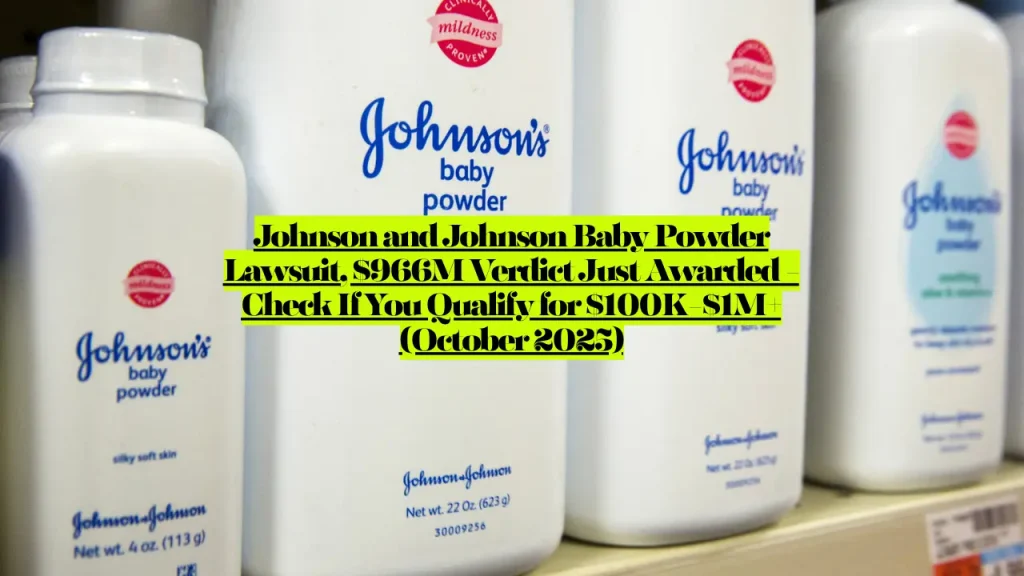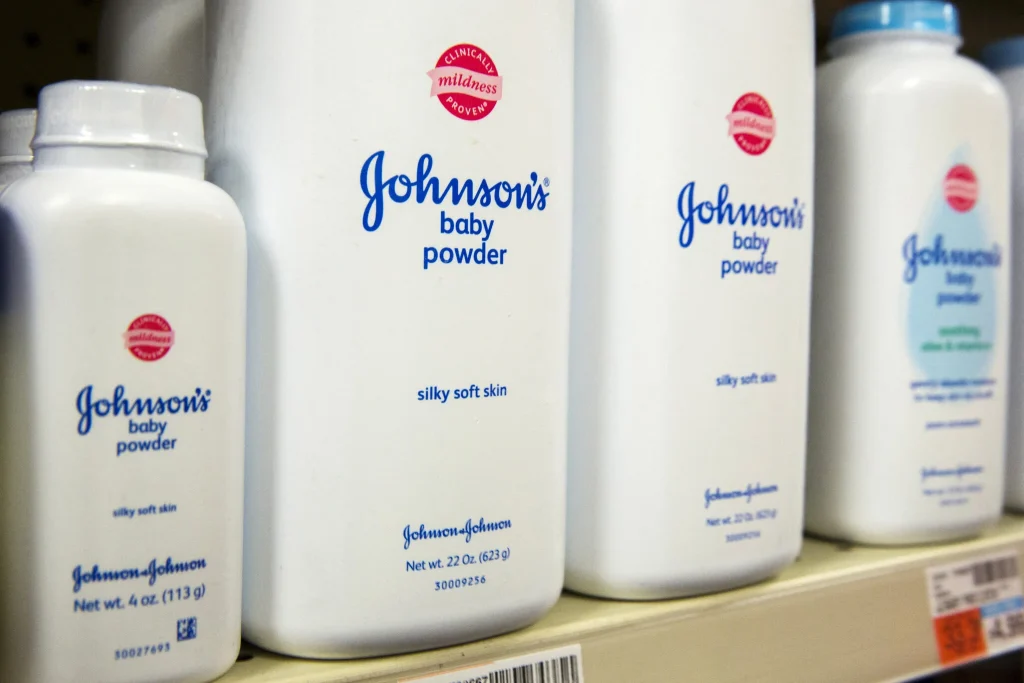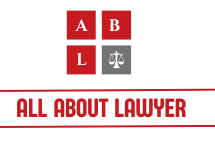Johnson and Johnson Baby Powder Lawsuit, $966M Verdict Just Awarded – Check If You Qualify for $100K-$1M+ (October 2025)
Breaking Development: $966 Million Verdict Signals New Chapter in Ongoing Legal Battle
A jury recently ordered Johnson & Johnson to pay $966 million after finding the company liable in a talc cancer case, awarding $16 million in compensatory damages and $950 million in punitive damages. This landmark verdict comes as the company’s attempts to settle thousands of lawsuits through bankruptcy have repeatedly failed.
If you or a loved one developed ovarian cancer or mesothelioma after using Johnson & Johnson’s talc-based baby powder, understanding your legal rights has never been more critical.
Current Status: Settlement Rejected, Lawsuits Moving Forward
In March 2025, a bankruptcy judge rejected Johnson & Johnson’s $8 billion settlement proposal to resolve talc ovarian cancer claims, marking the company’s third failed attempt at using bankruptcy to avoid talcum powder lawsuits.
What this means for you:
- Individual lawsuits are proceeding through the court system
- More than 65,000 lawsuits have been filed against Johnson & Johnson related to its talcum powder products
- Recent jury verdicts show substantial compensation is being awarded
- New claims can still be filed
Table of Contents
Understanding the Health Allegations
The lawsuits center on serious health concerns connected to talc-based baby powder:
Ovarian Cancer Connection
Thousands of women claim long-term use of talc-based products in the genital area led to ovarian cancer development. Scientific studies have explored the potential link between talcum powder application and increased cancer risk.
Mesothelioma and Asbestos Contamination
Other lawsuits allege that Johnson & Johnson’s talc products contained asbestos, a known carcinogen that can cause mesothelioma. J&J talc mesothelioma verdicts awarded $320 million to families in 2024 alone.
Recent Verdict Highlights
The legal landscape continues to evolve with significant jury awards:
The recent $966 million verdict could be reduced on appeal, as the U.S. Supreme Court has found that punitive damages should generally be no more than nine times compensatory damages. However, this substantial award demonstrates juries’ willingness to hold the company accountable.
Other notable verdicts include:
- A $55 million verdict in the Lois Slemp case against Johnson & Johnson’s talcum powder product
- A Louisiana jury awarded $3 million in damages for talc-related injuries
Are You Eligible to File a Claim?
You may be eligible to pursue compensation if you:
- Used Johnson & Johnson’s talc-based baby powder regularly
- Applied the product in the genital area for personal hygiene
- Were diagnosed with ovarian cancer or mesothelioma
- Can establish a connection between product use and your diagnosis
Time Limitations Apply
Each state has specific deadlines (statutes of limitations) for filing product liability claims. Don’t wait to explore your legal options.

What Compensation Can You Seek?
Based on recent verdicts and settlements, potential compensation may include:
Economic Damages:
- Medical expenses (past and future)
- Lost wages and earning capacity
- Cost of ongoing care and treatment
Non-Economic Damages:
- Pain and suffering
- Emotional distress
- Loss of quality of life
- Loss of consortium
Punitive Damages: Recent verdicts show juries are awarding substantial punitive damages designed to punish corporate misconduct and deter similar behavior.
The Claims Process: What to Expect
Step 1: Case Evaluation
Contact a qualified product liability attorney who can review your medical history, product usage, and diagnosis to assess your claim’s strength.
Step 2: Gathering Evidence
Your legal team will collect:
- Medical records documenting your diagnosis
- Purchase receipts or proof of product use
- Testimony about usage patterns and duration
- Expert medical opinions linking talc exposure to your condition
Step 3: Filing Your Lawsuit
Your attorney will file a complaint in the appropriate court jurisdiction, outlining your allegations and the compensation sought.
Step 4: Discovery and Trial Preparation
Both sides exchange evidence and information. Your case may proceed to trial or settle before reaching a jury.
Step 5: Resolution
Your case may resolve through:
- Settlement negotiations
- Jury trial verdict
- Appeal if necessary
Why the Bankruptcy Settlement Failed
U.S. Bankruptcy Judge Christopher Lopez said Johnson & Johnson’s $8 billion settlement proposal lacked enough support from women who filed claims and was too broad, as it would have released claims against entities that hadn’t filed for bankruptcy, including retailers.
Judge Christopher Lopez rejected Red River Talc’s bankruptcy plan, and J&J says it does not plan to appeal the decision and will instead focus on combating the existing litigation.
This rejection means individual lawsuits will continue, potentially leading to higher compensation for claimants than the rejected settlement offered.
Frequently Asked Questions
How much is my talc lawsuit worth?
Case values vary significantly based on:
- Severity of your illness
- Medical expenses incurred
- Impact on your life and family
- Strength of evidence linking talc to your condition
- Jurisdiction where your case is filed
Recent verdicts range from millions to nearly $1 billion, though individual results vary.
Can I still file a claim in 2025?
Yes. It’s not too late to file a talcum powder lawsuit and pursue financial compensation and justice. However, statutes of limitations vary by state, so prompt action is essential.
What if I don’t know how I was exposed to asbestos?
Experienced attorneys have the resources to identify all potential sources of exposure and link them to your condition, even if you’re uncertain about the exact source.
Will my case go to trial?
Many cases settle before trial, but the rejection of the bankruptcy settlement means more cases may proceed to jury trials, potentially resulting in higher awards.
How long does the legal process take?
Timeline varies depending on:
- Court jurisdiction and backlog
- Complexity of your case
- Whether settlement negotiations occur
- Trial scheduling and appeals
Cases may resolve in months or take several years.
Do I need to pay upfront legal fees?
Most product liability attorneys work on contingency, meaning they only receive payment if you win or settle your case. Always discuss fee arrangements during your initial consultation.
Taking Action: Next Steps for Potential Claimants
1. Document Your Product Use Write down everything you remember about:
- When you started using the product
- How frequently you applied it
- How long you used it
- Where you applied it
2. Gather Medical Records Collect all documentation related to your:
- Cancer diagnosis
- Treatment history
- Medical expenses
- Prognosis and ongoing care needs
3. Consult with an Attorney Seek legal counsel from attorneys experienced in talcum powder litigation who can:
- Evaluate your case’s merit
- Explain your legal options
- Handle the complex litigation process
- Fight for maximum compensation
4. Act Promptly Don’t delay. Statutes of limitations could bar your claim if you wait too long.
The Broader Impact: Consumer Safety and Corporate Accountability
The rejection of the settlement is a victory for plaintiffs seeking their day in court and underscores the importance of holding corporations accountable through the civil justice system, rather than allowing them to circumvent liability via bankruptcy maneuvers.
This litigation has broader implications for:
Consumer Protection: Highlighting the need for rigorous safety testing and transparency about product risks.
Corporate Responsibility: Demonstrating that companies must prioritize consumer safety over profits.
Legal Precedent: Establishing that bankruptcy cannot be used to escape accountability for harm caused by dangerous products.
Important Considerations
Medical Consultation is Essential
If you used talc-based products and have health concerns, consult with your healthcare provider immediately. Early detection and treatment of ovarian cancer and mesothelioma significantly impact outcomes.
Individual Results Vary
While recent verdicts are substantial, every case is unique. Compensation depends on your specific circumstances, evidence strength, and legal jurisdiction.
Stay Informed About Legal Developments
The Johnson & Johnson talc litigation continues to evolve with:
- New trials scheduled
- Ongoing scientific research
- Changing legal strategies
- Emerging evidence

Conclusion: Your Rights Matter
The rejection of Johnson & Johnson’s bankruptcy settlement and recent substantial jury verdicts send a clear message: corporations must be held accountable for the harm their products cause.
If you or someone you love developed ovarian cancer or mesothelioma after using Johnson & Johnson’s talc-based baby powder, you have legal rights. Thousands of individuals have already taken action, and many have received significant compensation.
Don’t let time run out on your opportunity to seek justice. The legal process can be complex, but experienced attorneys are ready to guide you through every step.
Important Disclaimer
This article is for informational purposes only and does not constitute legal or medical advice. Every legal case is unique, and outcomes depend on individual circumstances. If you believe you have a claim related to talc exposure:
- Consult with a qualified attorney experienced in product liability litigation
- Seek medical evaluation from healthcare professionals
- Do not rely solely on this information for legal decisions
The information presented here is based on publicly available sources and current legal developments as of October 2025. Laws, settlement offers, and legal strategies may change. Always verify information with qualified legal professionals.
Last Updated: October 2025
Sources: Federal court documents, recent jury verdicts, bankruptcy proceedings, and verified legal news coverage
About the Author

Sarah Klein, JD, is a licensed attorney and legal content strategist with over 12 years of experience across civil, criminal, family, and regulatory law. At All About Lawyer, she covers a wide range of legal topics — from high-profile lawsuits and courtroom stories to state traffic laws and everyday legal questions — all with a focus on accuracy, clarity, and public understanding.
Her writing blends real legal insight with plain-English explanations, helping readers stay informed and legally aware.
Read more about Sarah
